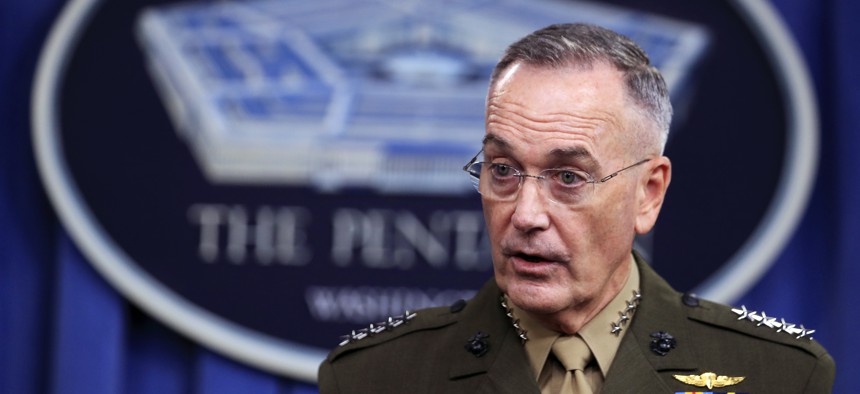Dunford: Time to Cut the Connections that Link ISIS’ Global Network
With the extremist group on its heels, coalition members must block its paths to Africa, Southeast Asia and elsewhere, the top US officer said.
The future of the war against the Islamic State is global, Chairman of the Joint Chiefs Gen. Joseph Dunford said this week. And the fight will require more than local partners; it’ll take an international effort to sever the connections between disparate extremist groups across the globe.
Not that the war in Iraq and Syria is done. Yes, Iraqi security forces won back ISIS’s Iraqi capital in July. Yes, Raqqa was liberated just this month. And yes, the U.S.-led coalition has reclaimed about 90 percent of the land ISIS had once controlled as part of its “caliphate,” U.S. Special Envoy to the coalition Brett McGurk told reporters Tuesday.
But “we are not shifting our attention away from Iraq or Syria yet,” Dunford said. There’s stabilization efforts that need to be stood up — from basic services like water, food and electricity to more grave governance concerns — and continued capacity-building of Iraqi security forces.
“Ideally, in the near future they will have the ability to be self-sustaining. When I say ‘near future,’ I’m saying three to five years,” he said. “It’s an effort that’s going to take some time.”
This enduring presence was one of the main points of discussion when 70 chiefs of defense met in Fort Belvoir this week to talk about the future of countering violent extremism, according to Dunford. But so was what comes next.
And that’s a future where ISIS, denied a physical territory in Iraq and Syria, will start to string together a global network of affiliated local insurgencies linked by small numbers of fighters, a flow of finances and resources, and a common ideology.
“The theme of today is that small numbers of ISIS leaders are attempting to leverage local insurgencies. And we see, in Africa, a number of local insurgencies that rebranded themselves and pledged allegiance to ISIS over the past year,” Dunford said.
That propagation of ISIS isn’t driven by the large flows of returning foreign fighters that military leaders feared just a year or two ago. All told, about 40,000 foreign fighters journeyed to fight with the Islamic State and join its caliphate, McGurk said. But the majority have not returned home. Instead, it’s small numbers of individuals helping locals foment violence and instability. The five-month siege of a Filipino city by an ISIS-affiliated groups ravaged the city and left at least 1,000 dead, but Dunford said the Philippines estimates just 30 or so ISIS foreign fighters returned to the islands from the Middle East.
And the number of local militant groups with which ISIS might link up will only grow as it becomes less secure in Iraq and Syria, Dunford warned.
“ISIS actually had some pretty strict criteria to be a part of ISIS maybe 12-18 months ago,” he said. “Now they’ve stopped sanctioning, if you will, organizations that want to be a part of ISIS.”
The chiefs of defense discussed pro-ISIS groups everywhere from Libya, the Sahel and East Africa to the Sinai, Afghanistan and Southeast Asia. Cutting the “connective tissue” that binds these far-flung groups will require better information- and intelligence-sharing, Dunford and McGurk said.
So when, if at all, can the coalition say that ISIS is defeated?
“ISIS is defeated when they no longer operate as a transregional terrorist organizations, and when the groups that maybe identify themselves as ISIS can be dealt with by local security forces,” Dunford said.
NEXT STORY: The Border-Wall Prototypes Are Up — Now What?





